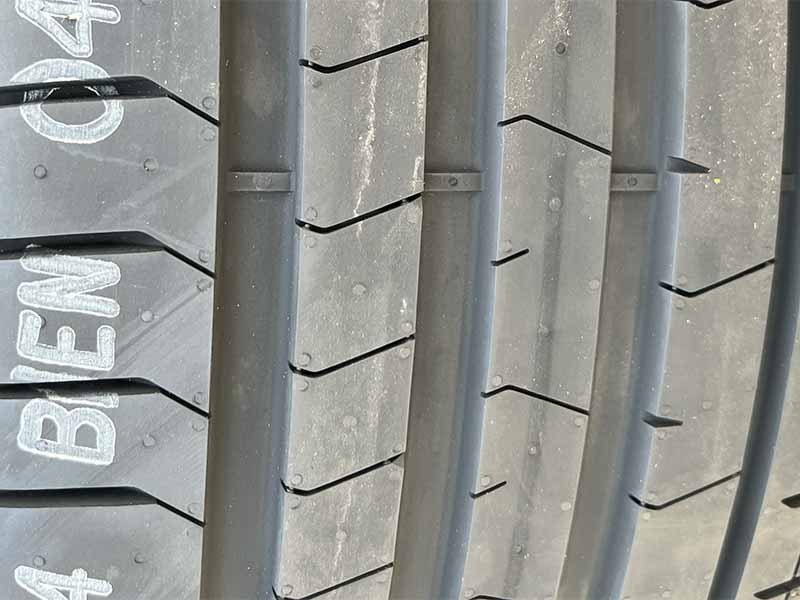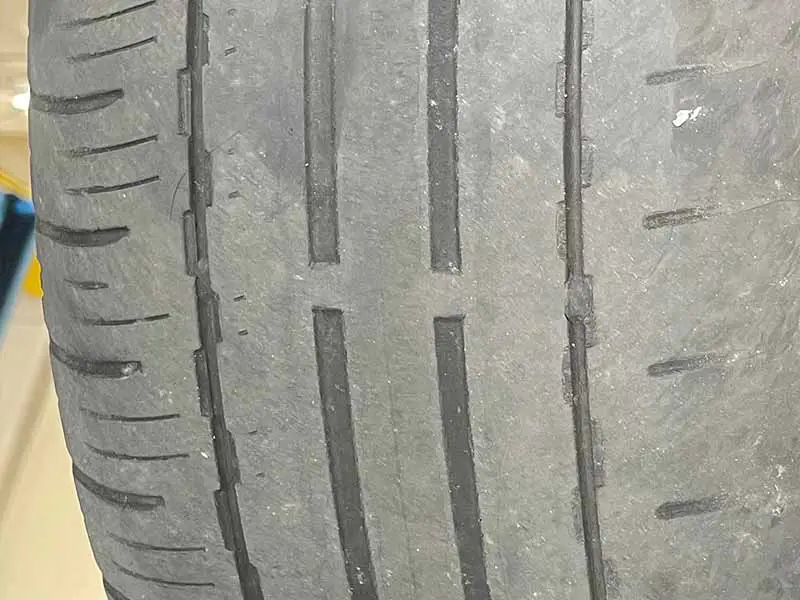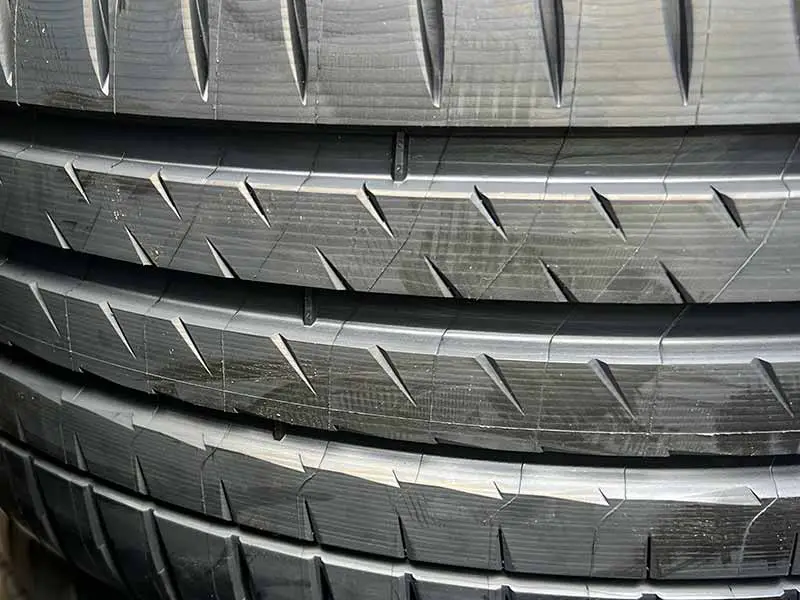Worn tires make a massive difference in driving safety in wet conditions. The deeper the grooves in your tire tread the better traction on wet road surfaces and the lower chance of hydroplaning.
Wear bars are one of the lesser-known parts of a tire that everyone really should have a good understanding of how they work.
Tire Wear Bars
Wear bars are tire tread wear indicator bars that are molded into the tread grooves of your tires at several points around the circumference.
These indicator bars are 2/32″ in height and represent the minimum legal tread depth. Once your tread wear reaches the same level as the treadwear bars you must discard the tires.
Wear bars make it possible to simply look at a tire to determine if it must be replaced or not.

The convenience of being able to easily look and see if you need to replace a tire improves driver safety. Looking at the tire’s tread and comparing the wear level to that of the tire wear indicator bars requires no tools and no real effort.
Let’s take a closer look.
What Is Tread Depth
Tread depth is the depth of the tread grooves around your tire. The grooves in your tires are responsible for channeling water out and away from underneath your tire as you drive down the road.
These grooves work best on new tires but gradually lose their ability to channel away water as the tires wear down and lose depth.
New tires usually start with 10/32″ or 11/32″ of tire wear. Once they wear down to only 2/32″ of tire tread depth your tires must be replaced.
2/32″ of tire tread depth is the minimum legal tread wear and is when your tires have lasted a significant amount of wet stopping performance and resistance to hydroplaning.
Safe Tread Depth
Even though 2/32″ of tread wear is the legal minimum, it isn’t very safe to drive on tires with this small amount of remaining tread depth. Tire performance in wet conditions is drastically reduced from that of tires with even only an additional 1/32″ of additional tread height.
Tread Depth To Replace Tires
It is usually recommended that you replace tires when they reach 4/32″ of tread left. This is the point that you will have used the majority of your tire life and still have reasonable performance on wet road surfaces.
The difference in wet road surface grip between 4/32″ and 3/32″ is much greater than the difference between 5/32″ and 4/32″. As your tire’s grooves become smaller they lose their ability to remove water from the contact patch more rapidly.
Tire Life Calculator
What Are Wear Bars On A Tire?
Wear bars are tread wear indicators that are molded as part of the tread pattern of your tires. They are designed to be a visual indication of the lowest allowable tread level.
If these wear indicator bars are lower than the tread blocks adjacent to them, you may continue using them. But that doesn’t necessarily mean that you should.
Where Are Tire Wear Bars
Wear bars are usually located at several points around the circumference of your tire and are found at the bottom of the main tread grooves.
More narrow grooves and tread design elements will not have these tread wear bars. They are only found at the bottom of the larger tire grooves.
Not all tires will have these tread wear indicator bars, but most tires do include them. Some tires will have different designs to indicate the bare minimum wear level, but wear bars are by far the most common indicator design.
Tire Wear Bars Depth
Tire wear indicator bars are placed at a depth of 2/32″ above the bottom of the tread groove. This is because this is the minimum legal tread level.
Once your tires have worn down to where the adjacent tread blocks are level with the tire tread wear bars, you know the tire’s tread has met or exceeded the lowest safety point to continue driving on them.
Do Tire Wear Bars Make Noise?
Wear bars are not designed to make noise, but many people do complain of tire noise as the tires wear down to the minimum depths.
There are various reasons for this, but the most common are uneven tread wear and the fact that there is less rubber on the tires to absorb sounds.

Driving On Wear Bars
Driving on wear bars is unsafe and illegal in most states around the country. If the tops of your tread blocks are no longer taller than the wear bar next to them, you should replace your tires immediately.
Tires worn to the same height as the tread wear bars have less than 2/32″ of tread left and have very little groove height for channeling water away from underneath the contact patch of your tires.
Braking abilities in wet conditions will be extremely poor and stopping distances will be much longer than new tires, or even tires with an additional 1/32″ of tread left.
How To Read Wear Bars On Tires
Tire wear bars are very simple indicators. If you have tire tread thicker than the wear bars then you have more than the legal minimum required. If your tire wear bars are the same height as the tire tread depth around it, you need to replace your tires immediately.
Having a little extra tread above the indicator bars doesn’t mean that you have a safe amount of tread remaining though. To get a more accurate reading, you should use either the penny test or a tread depth gauge to measure the remaining tread level.
How To Measure Tread Depth
Determining accurately how much tread is remaining on your tire treads can only be done with wear bars when they line up perfectly with the wear bars themselves. But once that happens you can’t really tell if you’ve reached 2/32″ or already past that point. They’re really only meant to let you know when you need to replace your tires.
You can get a bit more accurate measurement with the penny test, or for a truly accurate measurement, you can use a tread depth gauge.
How To Check Tread Depth With A Penny
Place a penny with Lincoln’s head upside down in one of the large grooves of your tread pattern.
- If you can see all of Lincoln’s head, you should replace the tire.
- If you can see all of Lincoln’s forehead, you should replace your tires soon.
- If you can see only some of Lincoln’s forehead, your tire has plenty of tread remaining.
How To Use A Tread Depth Gauge
A tread depth gauge is a tool that will measure the amount of remaining tread in either inches or millimeter measurements. Here in the United States, we use inches and the increments are in 1/32″ units.
There are several types of tread depth gauges on the market and all will work well. If you’re thinking of purchasing one for yourself, I recommend a dial gauge. They’re much easier to read and the plunger action is much more smooth than some of the cheaper alternatives.
Do You Measure Tread Depth From The Wear Bar?
When measuring how much tread you have remaining you should place the probe of your gauge (or edge of your penny if using the penny test) at the bottom of the groove and not on the wear bar.
Wear bars are only designed to be a visual indication of whether you need to replace a tire or not. It shouldn’t be included in the measurement.
Resources
Below are some links you may find helpful when learning about tires
- The importance of tread depth – Continental Tires
- What are wear bars and what do they do? – Tires Plus
Final Thoughts
Tires obviously play a key role in your safety and the safety of others on the road. Fortunately, most tires include wear bars to make ensure they are still able to provide some surface grip in wet weather.
But tire performance doesn’t remain the same as new tires until they reach the minimum level. They gradually lose traction on wet roads until their stopping distance ability to come to an emergency stop from 70mph in moderate rain conditions can more than double.
You should consider replacing your tires once they reach 4/32″ to ensure you still have adequate performance in rainy weather.
Good luck and happy motoring.







